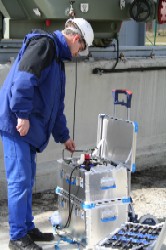Extraction Gas Sampler (EGS)
for Manual Gas-in-Oil Analysis
|
Application
 The EGS method is a simple and reliable way of obtaining a defined gas sample from an oil sample for gas chromatographic analysis of the gases dissolved in oil in order to obtain the individual gas contents, the total gas content, the solution pressure and the degree of gas saturation for transformer diagnostics on a quality-based criterion, the Natural Internal Standard
(NIS).
The EGS method is a simple and reliable way of obtaining a defined gas sample from an oil sample for gas chromatographic analysis of the gases dissolved in oil in order to obtain the individual gas contents, the total gas content, the solution pressure and the degree of gas saturation for transformer diagnostics on a quality-based criterion, the Natural Internal Standard
(NIS).
|
 |
Advantages of the EGS method
- Minimisation of fault influences during sampling
- Continuous hermetic conditions from oil sampling till gas dosing for GC analysis
- Two-phase oil-and-air system is not a problem in case of gas separation processes in the oil during transport and storage
- No additional equipment or time for gas extraction
- No direct handling of the oil during extraction
- No oil contamination in the laboratory
- EGS can be used for complete laboratory analysis or on-site analysis of the fault gas part
- Quality check possible without time delay and without external Standard (NIS)
- Optional use of an auto-sampler for GC analysis in the laboratory
- Access to the diagnostic service of GATRON GmbH or application of known monitoring criteria
- Significant cost reduction
- Oil sample available for selected oil parameters (DBPC, Furans)
|
 |
Short description

- All data of a transformer is recorded in a form in relation to the seal number.
- The preferred sampling option is "vessel bottom", where approx.1l of oil is drained before connecting the EGS.
- When the EGS is completely filled with oil, wait until the oil flow temperature is constant, then close the EGS cocks.
- The EGS filling tube is taken out of and the original seal (sample number, included septum, retaining ring) is used for final sealing.
- Oil filling and air temperatures have to be recorded.
- On-site analysis
- Shake EGS by hand approx. 15 min, puncture seal till the septum and equalise pressures.
- Dosing in portable GC and analysis of the fault gas sample (H2, CO, CO2, CH4, C2H2, C2H4, C2H6, C3H6, C3H8).
- Calculation of fault gas contents
- Laboratory analysis
- Record air pressure and put EGS into a transport container.
- In the laboratory: Attach transport vessel to the horizontal shaker and keep the thermal and solution equilibrium for approx. 60 min.
- In vertical position: puncture EGS seal after approx. 10 min of calming, measure the internal pressure via the septum and equalise pressures.
- Dosing in GC and complete gas analysis (H2, O2, N2, CO, CO2, CH4, C2H2, C2H4, C2H6, C3H6, C3H8).
- Record laboratory temperature and air pressure, complete calculation of the final result including individual gas contents, total gas content, solution pressure, degree of gas saturation.
- Quality check using the NIS criterion.
|
 |
 |
Sampling Management with EGS Techniques
|
1. Specification of sampling
|
Power Transformers
> 5 MVA |
Small hermetical transformers
< 5 MVA |
| Insulation liquid |
> 1 t (free flow) |
< 1 t (hermetic sealing) |
EGS techniques
Sampling volume |
EGS-Oil-2
> 5 l |
EGS-Oil-2 / EGS-P
< 2,5 l
(Preservation of hermetical conditions) |
EGS-100
< 0,75 l
(Preservation of hermetical conditions) |
Volume of sample
Analytical parameters |
1,25 l
VDE, DGA, Furans |
1,25 l
VDE, DGA, Furans |
0,1 l
DGA, Furans, possibly H2O |
| Options |
EGS-P Coupling at low temperatures (Filling Help) |
Repatriation of external insulation liquid |
Repatriation of catched insulation liquid (0,5 l) |
|
2. EGS Technique Component

Service Box EGS-S
|

Sampling Box EGS-Oil-2
|

Sampling Box EGS-100 |

Oil Pump EGS-P |
|
3. Transport Logistics

EGS-6T
small sampling
|

EGS-20T
big series sampling
|

Oil-3T
small series sampling
|

Oil-15T
big series sampling
|

EGS-Oil-1T
single sampling (complete)
|

RSP-10
single sampling (resaturation)
|

EGS-100T4 |

EGS-100T7 |
|
 |

 The EGS method is a simple and reliable way of obtaining a defined gas sample from an oil sample for gas chromatographic analysis of the gases dissolved in oil in order to obtain the individual gas contents, the total gas content, the solution pressure and the degree of gas saturation for transformer diagnostics on a quality-based criterion, the Natural Internal Standard
(NIS).
The EGS method is a simple and reliable way of obtaining a defined gas sample from an oil sample for gas chromatographic analysis of the gases dissolved in oil in order to obtain the individual gas contents, the total gas content, the solution pressure and the degree of gas saturation for transformer diagnostics on a quality-based criterion, the Natural Internal Standard
(NIS).
